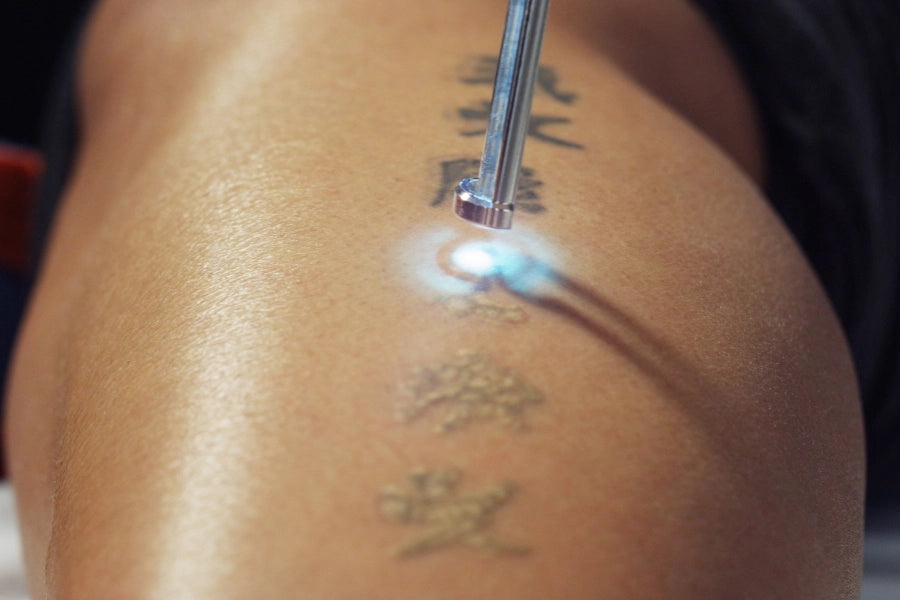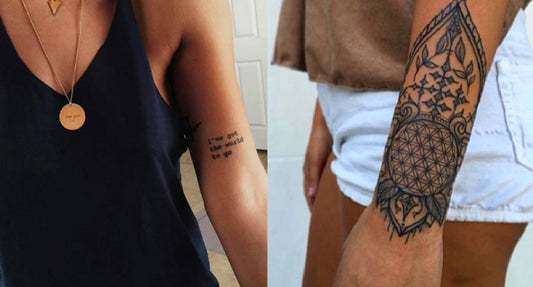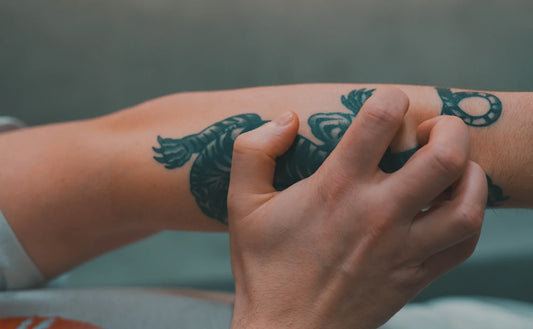
How To Remove a Tattoo You Regret
Removal of a tattoo isn’t all that different than getting a tattoo in the first place. That is to say, there’s more than one way to do it and no matter which method you land on, it’ll probably leave a mark. Speaking of different methods, did you know that some people remove their tattoos at home, or at least try to? Before you go all DIY on tattoo removal, please consult with a doctor and consider your options.
Ultimately, the removal of a tattoo takes three different forms: laser surgery, surgical removal, and home remedies. If you have the money to spare and a tattoo you regret, allow us to save you some time by recommending laser removal, which is easily the best method amongst the three. That said, don’t just Google “laser tattoo removal” and book an appointment with the nearest specialist, as laser surgery can vary in terms of quality and outcome—more on that later.
On the flip side of the spectrum are home remedies, which are more popular now than ever before. However, before you employ tattoo removal in your home or apartment, you’ll definitely want to read up on what works and what doesn’t (spoiler alert: most methods don’t work). After all, the last thing you want when removing something you regret is to create something else you’ll regret. Indeed, who would’ve guessed that removing tattoos at home would be dangerous and largely ineffective? Go figure.
But we’re getting ahead of ourselves, kind of like you did when you got that tattoo in the first place (just kidding—we’re not judging you). Let’s start with the basic premise that you have a tattoo you regret and move forward from there.

What to Expect from Tattoo Removal
Nothing is created equal when it comes to tattoos and tattoo removal alike. Even when you’re dealing with the same general procedure (i.e. laser removal), variations in both the technology and the tattoo will yield different results. Here are some pointers to keep in mind:
Certain Colours are Harder to Remove than Others
Generally speaking, colours such as red, blue, and black are easiest to remove, while orange, yellow, pink, purple, and brown are harder to remove. The most difficult shades of ink to remove are green, light blue, teal, and basically any neon colours. All this said, modern laser technologies like PicoSure and Q-switched reportedly tackle pretty much every colour with equal efficiency.
The Better the Tattoo, the Harder it is to Remove
You spent a whole month searching for the best tattoo artist and then spent another month on the waiting list. At long last, he or she inked you up and went full Salvador Dali, turning your flesh into an eye-catching tapestry. The good news is you probably ended up with a really sweet tattoo. The bad news is your tattoo is going to be much harder to remove than some amateur job, which typically wouldn’t dig as deep into the skin.
Keep Your Tattoo Close to the Heart
No, we don’t mean you should get something meaningful, though it wouldn’t hurt. According to experts, the closer a tattoo is to your heart or your larger blood vessels, the easier it is to remove. As such, knuckle, hand, feet, and ankle tattoos are typically the most difficult to eradicate.
There Will Be Aftermath
From lingering pain to visible scarring, you can expect there to be a period of time where the removed ink represents a tattoo of its own, figuratively speaking. Even the most sophisticated procedures will require additional TLC and leave some sort of physical residue, at least for a little while.

Laser Surgery vs Surgical Removal
Once you’ve decided to remove your tattoo, you’ll want to seek medical advice. That means sitting down with a dermatologist or plastic surgeon who specialises in tattoo removal. And while some tattoo parlours might offer removal, we don’t recommend taking this route. It’s always best to leave dramatic procedures in the hands of a medical professional.
During your consultation, the doctor will examine your tattoo and suggest either laser removal or surgical removal. Here’s what you can expect from either procedure:
Laser Tattoo Removal
For nearly all tattoos, laser removal is typically your first and best option. It generally works by pointing lasers at the tattoo and breaking down the pigments until they leave the flesh. As you can probably guess, your mileage may vary depending on a handful of factors (starting with cost).
Meanwhile, the best laser tattoo removal has never been as optimal as it is right now. That’s largely thanks to picosecond lasers, which typically cost the most and work the fastest. No matter which laser procedure you land on, expect the following:
- You will likely require multiple treatments. Each treatment will be generally short, but the skin needs time to recover. To expedite, you can apply a DeScribe patch—which protects the skin and reduces recovery time—and hang out inside the doctor’s office for a few hours. This will allow you to undergo more than one laser treatment during a single visit. Overall, it can take between 6 and 10 treatments to remove your tattoo.
- A medical professional will apply a local anaesthetic (such as lidocaine) to numb the skin. As a result, you won’t feel much pain during the actual treatment.
- Each session can take about 45 minutes or more. This includes taking photos of the tattoo, injecting anaesthetic, freezing the area, applying the lasers, and bandaging. The actual laser treatment is fairly brief. Naturally, the session time can vary based on the size of your tattoo and type of laser treatment. Picosecond lasers will take the shortest amount of time.
- You can stop after a few sessions and settle for faded ink. In no time at all, that faded ink can become a clever new tattoo.
- You will probably smell burning flesh. Hey, these are lasers after all.
- There will be pain afterward. You did read the part about lasers and burning flesh, right?
- You might experience swelling, blisters, or bleeding. There are antibiotic ointments, bandages, and moisturisers you can use to help accelerate the healing. You should also avoid contact with the area.
- There will probably be scarring. If you opt for full removal, you can expect some scarring. Thankfully, there are additional laser treatments that can remove the scars.
- You’ll likely have to pay out of pocket. This is an elective procedure and your insurance probably won’t cover it.
Surgical Removal
If your tattoo is small enough, you can opt for surgical removal. In this procedure, the doctor uses a scalpel to literally cut the tattoo out of your flesh. Here’s what to expect:
- A medical professional will apply a local anaesthetic to numb the skin.
- Upon removal of the tattoo, the doctor will stitch the skin back together.
- There will be scarring.
- For larger tattoos, you might need a skin graft. Be forewarned that this procedure—which involves taking skin from elsewhere on your body and applying it to the removal area—can lead to infection or complications.
Dermabrasion
If you’re on a budget and still hoping for professional tattoo removal, dermabrasion might be your best bet. This is where the doctor removes the top layer of skin and dyes out the remaining ink. Typically, it’s not as effective as lasers or surgical removal. It also takes longer to recover from, with up to 2-3 weeks of bleeding and swelling. But hey, at least you saved a few grand.

Home Remedies
Tattoo removal at home has become quite popular in recent years, though we don’t necessarily recommend it. At the very least, you should avoid store-bought miracle creams or balms, most of which don’t work and none of which are approved by the FDA. Along similar lines, stay far away from DIY chemical peels and for obvious reasons, unless burnt flesh and various doctor visits are what you’re after.
Should you insist on removing tattoos at home, here are some methods you can review. And notice how we wrote “review” and not “try” because we honestly don’t suggest trying any of this stuff. Odds are you didn’t give yourself the tattoo and we don’t know why you’d try to remove it on your own. Nevertheless, here are some methods other people have employed. Expect some scarring.
- Salt and lemon juice. Mix 100g of salt with a little lemon juice to form a thick paste. Soak a cotton pad in the mixture and apply it to the tattoo for 30 minutes or more. Rinse using warm water.
- Aloe vera, salt, honey, and yoghurt. Mix 2 tablespoons of aloe vera gel, 2 tablespoons of salt, 2 tablespoons of honey, and 2 tablespoons of yoghurt. Apply to your tattoo and soak for a minimum of 30 minutes. Rinse with warm water.
- Table salt. Apply table salt to a moist gauze sponge and sand down your skin for about 30-40 minutes, until the area turns dark red. Next, apply antibiotic ointment and cover the area for 3 days. After a week’s time, you can peel the top layer of skin off, thereby chipping away at the tattoo. You might have to perform this ritual a few times and if you do, wait at least 6-8 weeks before the next treatment. Please be advised that there’s a good chance you’ll experience scarring or infection. There’s also a good chance that you’re an idiot, hence your willingness to employ this method in the first place.
- Homemade tattoo removal cream. Combine 1 tablespoon of aloe vera gel, 2 capsules of vitamin E, and 1 tablespoon of the gel created by Paederia Tomentosa leaves. Mix and apply to the area, soaking it for 10 minutes. Rinse with warm water. Repeat 4 times a day for 1 week or more.
FAQ
Can you completely remove a tattoo?
Thanks to technologies like PicoSure and Q-switched lasers, you can completely remove a tattoo after various sessions. However, there might be some scarring.
What is the best method to remove tattoos?
The best method to remove tattoos is picosecond laser treatments using technologies such as Q-switched or PicoSure.
How much does it cost to remove a tattoo?
Laser tattoo removal is completed over the course of various sessions, costing anywhere from $200 to $500 per session.
Is tattoo removal painful?
While the actual procedure of laser tattoo removal is relatively painless, there will be some pain once the anesthetic wears off.
Does tattoo removal cream work?
DIY tattoo removal creams and balms are not FDA approved and most—if not all—of them don't work, according to experts.
Can salt and ice remove a tattoo?
Using salt and ice to remove a tattoo will most likely result in rashes, frostbite, or skin damage. It is not known to work and is not recommended.










